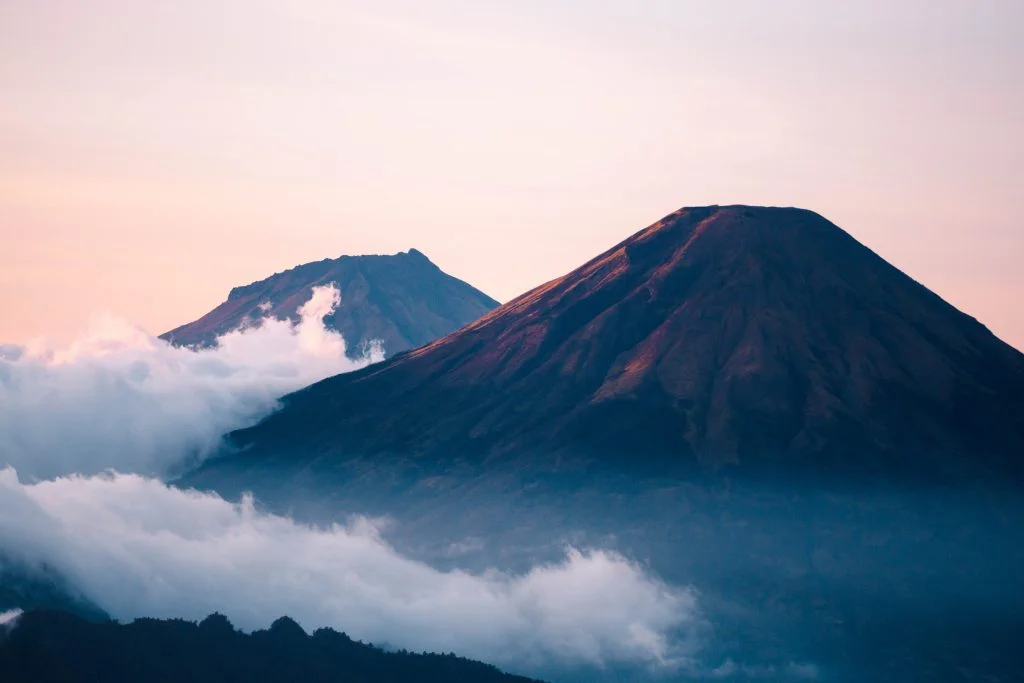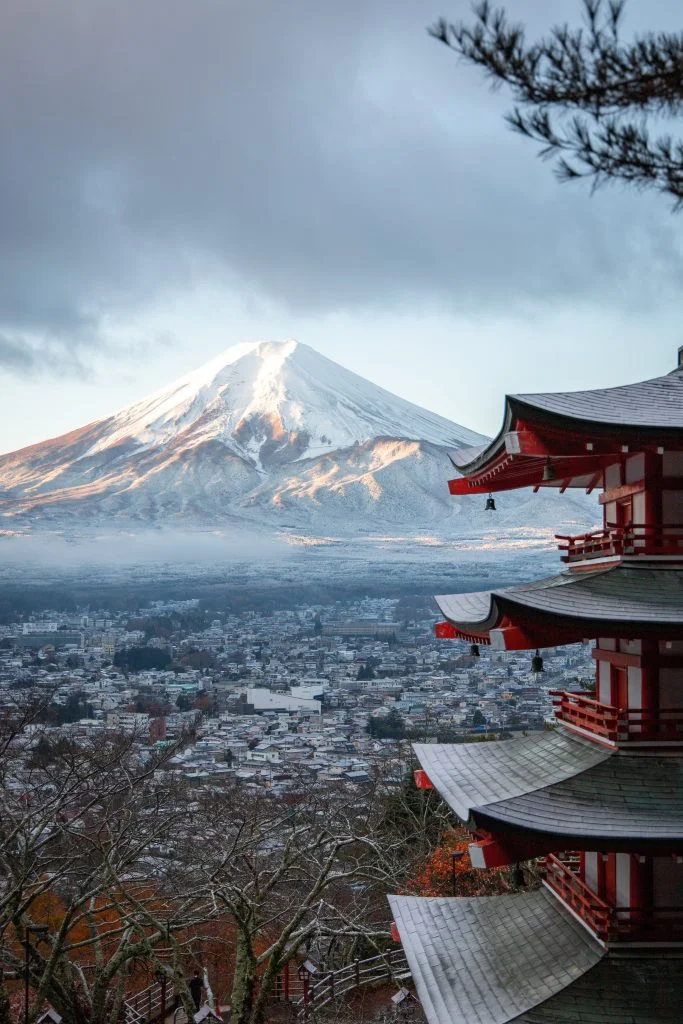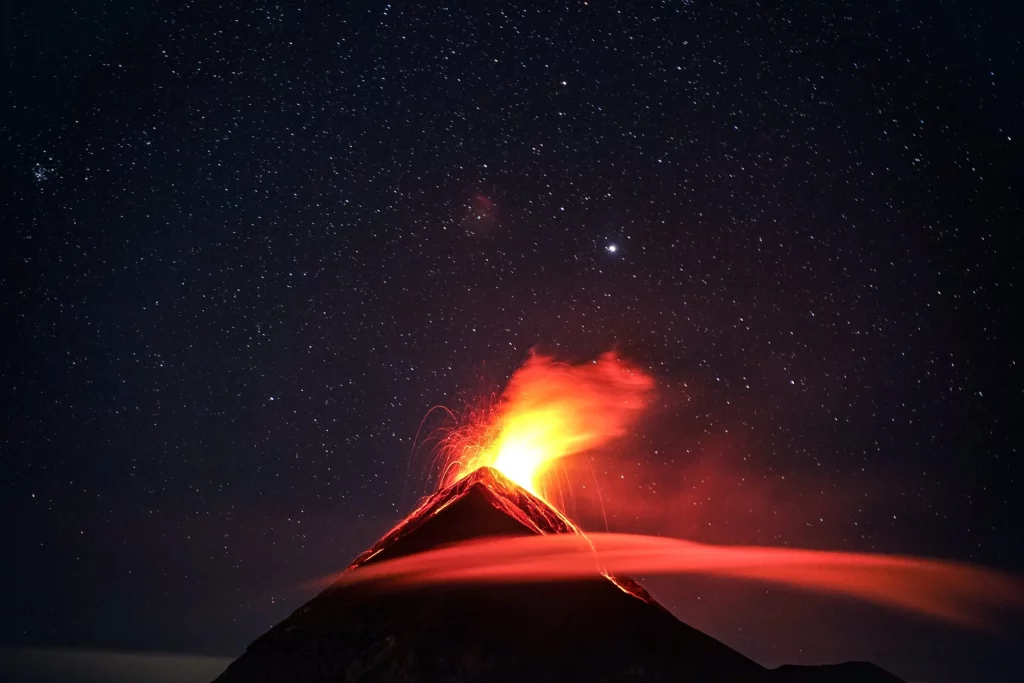Hello there, fellow earthling! Did you know that volcanoes are basically the Earth’s way of letting off steam, quite literally? My love affair with volcanoes began when I mistook a mud volcano for a spa treatment (true story, or not). Since then, I’ve dived deep into the molten world of these fiery beasts, uncovering 50 sizzling facts that will blow your mind like a volcanic eruption.
Do you know the difference between a lava flow and my homemade chili? One’s a slow-moving river of fire, and the other’s just lava. Join me as we explore these natural wonders, but remember to bring a heat-resistant hat; things are about to get hot!
A volcano may be considered as a cannon of immense size.
Oliver Goldsmith
Volcanoes Facts
Dive with me into the world of molten mysteries as we explore some intriguing facts about volcanoes. Make sure to read every detail, because there’s a quiz at the end to test your volcanic expertise!
- The Lava Lake in the crater of Erebus in Antarctica is one of the few permanent lava lakes on Earth, offering a rare glimpse into a persistently molten state.
- Supervolcanoes have the power to produce eruptions with ejecta volumes greater than 1,000 cubic kilometers, capable of causing long-term climatic changes.
- The term “volcano” originates from Vulcan, the Roman god of fire, linking these natural phenomena to ancient myths of divine fire.
- Parícutin in Mexico is one of the youngest on the surface of the Earth, emerging suddenly in a farmer’s field in 1943.
- The deepest known under the sea is Kick-’em-Jenny, located north of Grenada, showcasing the hidden power beneath our oceans.
- Volcanic ash can travel hundreds to thousands of kilometers from its source, affecting aircraft operations and human health across continents.
- The Tambora eruption in 1815 led to the “Year Without a Summer,” causing global climate anomalies and widespread harvest failures.
- Volcanic soil is incredibly fertile, leading to abundant agricultural production around many volcanic areas.
- Yellowstone National Park sits atop a massive caldera, evidence of past supereruptions that shaped the landscape and continue to fuel its geothermal features.
- The Volcanic Explosivity Index (VEI) measures eruption magnitude, with values ranging from 0 to 8, indicating the volume of material ejected.
- Lava tubes can form during eruptions, creating natural tunnels as the surface lava cools and insulates the flowing lava beneath.
- Pyroclastic flows, a mixture of hot gas, ash, and volcanic material, can race down slopes at speeds of up to 700 km/h, obliterating everything in their path.
- The highest volcano in the Solar System is Olympus Mons on Mars, standing at a staggering height of about 22 km (13.6 miles).

- Volcanic lightning, known as dirty thunderstorms, can occur within the ash clouds of eruptions, creating spectacular and dangerous light shows.
- Pillow lava forms when lava erupts under water, cooling rapidly to create distinctive, pillow-shaped formations.
- The Ring of Fire is a major area in the basin of the Pacific Ocean where a large number of eruptions and earthquakes occur due to tectonic plate boundaries.
- Volcanic bombs are large rocks thrown from an eruption that were molten when ejected, cooling into aerodynamic shapes as they fly.
- Geothermal energy from volcanic areas provides a sustainable energy source, tapping into the Earth’s internal heat.
- The sound of the Krakatoa eruption in 1883 was one of the loudest sounds ever reported, heard up to 4,800 km (3,000 miles) away.
- Volcanic islands such as Iceland are formed by repeated eruptions over thousands of years, creating new land in the ocean.
- Mauna Loa in Hawaii is the world’s largest shield volcano, with a volume estimated at approximately 75,000 cubic kilometers.
- Volcanoes can have multiple vents that release lava and gases, creating complex eruption patterns and new landforms.
- Acid rain can result from volcanic eruptions, as sulfur dioxide and other gases mix with atmospheric moisture to form acidic precipitation.
- The atmosphere of Venus is thought to be the result of volcanic activity, with dense clouds of sulfuric acid and a runaway greenhouse effect.
- Submarine volcanoes can form new islands, but their eruptions are often undetected due to the vastness of the oceans.
- Volcanic glass, such as obsidian, forms when lava cools rapidly without crystallization, resulting in a smooth, glass-like texture.
- The Deccan Traps in India are one of the largest volcanic features on Earth, covering an area of about 500,000 square kilometers.
- Volcanic winter can occur after massive eruptions, with ash and sulfur dioxide in the atmosphere reducing global temperatures.

- Extremophiles, organisms that thrive in extreme environments, can often be found in the hot, acidic conditions of volcanic areas.
- The first recorded eruption dates back to 1500 BCE at Thera, an event that significantly impacted ancient Mediterranean civilizations.
- Lahars, or volcanic mudflows, can be as destructive as lava flows, burying everything in their path under mud and debris.
- Volcanic arcs form as a result of the subduction of an oceanic plate beneath a continental or another oceanic plate, leading to frequent eruptions.
- The petrology of volcanic rocks helps scientists understand the Earth’s interior and the processes that drive eruptions.
- Ash plumes can disrupt global air travel, as the fine particles can damage aircraft engines and affect visibility.
- Volcanic CO2 emissions contribute to the greenhouse effect, but human activities release far more CO2 annually.
- The formation of calderas occurs after the magma chamber empties and collapses, often leaving a large, basin-like depression.
- Cryovolcanism refers to the eruption of water, ammonia, or methane instead of molten rock, observed on icy moons and dwarf planets.
- Volcano monitoring techniques include seismic activity measurements, gas emissions analysis, and satellite imagery to predict eruptions.
- Volcanic rock types, such as basalt, andesite, and rhyolite, reflect the composition and cooling process of the magma.

- The concept of Plinian eruptions is named after Pliny the Younger, who described the catastrophic eruption of Vesuvius in 79 CE.
- Hotspot volcanism creates chains of islands as tectonic plates move over stationary magma sources, like the Hawaiian Islands.
- Sulfur mining at active volcanic sites, such as Kawah Ijen in Indonesia, poses significant risks to workers due to toxic gases and high temperatures.
- Volcano tourism attracts thousands to active and dormant sites each year, offering unique experiences but also posing safety challenges.
- The Galápagos Islands are an example of volcanic islands that have become laboratories for the study of evolution due to their unique biodiversity.
- Volcanic sapphires and other gemstones can form in the high-temperature and pressure conditions associated with eruptions.
- Shield volcanoes have gentle slopes due to the low viscosity of their lava, allowing it to spread over large areas.
- The volcanic front is the region where the probability of volcanic activity is highest, typically parallel to a subduction zone.
- Volcanic smog or “vog” is a form of air pollution that results from the release of sulfur dioxide and other gases into the atmosphere.
- Fumaroles, openings that emit steam and gases, are indicators of volcanic activity and heat just beneath the surface.
- The interaction between glacial ice and volcanic activity can lead to explosive eruptions, as seen in Iceland, where the heat melts the ice, generating massive steam explosions and flooding.
Volcanoes Myths

Is lava the most dangerous aspect of a volcano? Is this a myth or not? Let’s see some of the most popular myths about volcanoes together.
- Volcanoes Can Spontaneously Erupt Without Warning
Modern technology and geological monitoring allow scientists to detect signs of potential volcanic activity well in advance. These signs include seismic activity, gas emissions, and changes in the volcano’s shape. - Lava is the Deadliest Aspect of Volcanoes
While lava flows are iconic, they are often less deadly than other volcanic hazards like pyroclastic flows, lahars (volcanic mudflows), and ash fall, which can have more immediate and widespread impacts. - Volcanoes Only Erupt Once and Become Dormant
Volcanoes can have periods of dormancy, followed by reactivation. Some volcanoes remain active for years, periodically erupting, while others can awaken suddenly after centuries of inactivity. - All Volcanic Eruptions are Explosive and Violent
Volcanic eruptions vary widely in intensity. Some, like those in Hawaii, can be effusive, producing gentle lava flows, while others can be explosively violent, like Mount St. Helens in 1980. - Volcanoes Only Occur in Remote, Unpopulated Areas
Many volcanoes exist near populated areas. The proximity of communities to volcanoes, like those in Indonesia or Italy, often poses significant risks and necessitates careful monitoring and evacuation plans.
No products found.
Volcanoes FAQ

Now it’s time to see some questions about volcanoes that I found around the net while researching the facts. Read carefully because you have to prove your knowledge in the next section.
- Where are volcanoes located?
Most volcanoes form along tectonic plate boundaries like the Pacific Ring of Fire, at mid-ocean ridges, and over hotspots like Hawaii. - How do volcanoes erupt?
Eruptions occur when magma from beneath the Earth’s crust rises, forced by gas pressure, and erupts as lava, ash, and gases. - How are volcanoes formed?
Volcanoes form from magma reaching the Earth’s surface, often at tectonic plate boundaries or over mantle hotspots, building up over repeated eruptions. - How many volcanoes are there in the world?
There are over 1,500 potentially active volcanoes worldwide, including those on land and underwater. - How is lava made?
Magma, molten rock, forms lava under the Earth’s crust due to high temperatures and pressures or at subduction zones.
Volcanoes Quiz

Ready to erupt with knowledge in my volcano quiz? But beware; zero correct answers might leave you buried under a mountain of ‘ash-amed’ (I feel bad for this pun).
Conlcusion
And that’s a wrap on our explosive journey through the world of volcanoes! These natural fireworks are more than just a hot mess; they’re the earth’s way of keeping things interesting. Always remember, behind every plume of smoke is a story waiting to erupt.
What do you think? Should we send a thank-you note to Mother Nature for these spectacular shows, or just a friendly reminder to keep the lava to a minimum? Let me know in the comments what you think about it.


